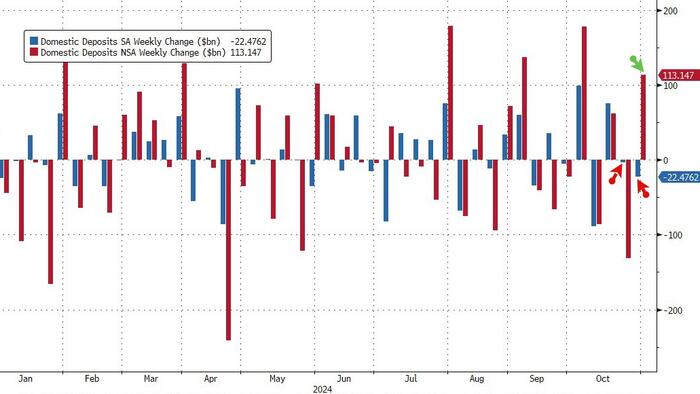Last week, money market funds experienced a slight net outflow of $2.2 billion, a marked change that keeps them just below record high levels. Despite this small dip, investment in money market funds remains robust, reflecting investors’ cautious optimism amidst fluctuating financial conditions. The outflow indicates a shift as investors might be reallocating their assets, but the decrease is minor when viewed against the overall context of growing interest in these types of funds. Money market funds typically attract investors looking for safer, liquid investments, especially during uncertain economic times.
In the banking sector, total deposits witnessed a notable increase of $17.5 billion, marking the highest level since September 2022. This rise in deposits indicates a strengthening confidence among consumers and businesses in the banking system, suggesting that individuals are either saving more or receiving greater disposable income. The seasonally adjusted gains reflect general optimism in the economy, as consumers might be more inclined to stock up on savings in preparation for potential economic fluctuations or future investments.
Contrasting with the overall increase in deposits, data presents a curious anomaly. Excluding foreign deposits, U.S. banks recorded a $22 billion net outflow in deposits on a seasonally adjusted basis during the week ending October 30. This figure stands in stark contrast to the non-seasonally adjusted figure, which indicated a substantial $113 billion inflow. It highlights the complexities within the banking system, suggesting that while overall deposits are increasing, certain dynamics are contributing to an outflow in some segments of the banking market.
Breaking it down further, large banks saw significant inflows totaling $86 billion, while small banks attracted $27 billion in the same timeframe. However, this trend took a different turn on a seasonally adjusted basis, where large banks reported $21 billion in outflows and small banks registered a more modest $1.5 billion decline in deposits. These findings illustrate a divergence in consumer behavior, which could be attributed to differences in the services and products offered by large versus small banks, as well as varying consumer preferences during this unique economic phase.
Moreover, the data indicates that while small banks are experiencing a shrinkage in loan volumes, larger banks have seen a substantial increase in lending activity. This divergence could suggest that larger banks are better positioned to meet demand for loans amid changing economic conditions, possibly driven by their ability to leverage more robust capital reserves and broader funding options. The contrasting trends in deposit inflows and loan volumes between small and large banks may also reflect evolving banking client needs and preferences, impacting the competitive landscape within the industry.
Lastly, despite the fluctuations in deposits and consumer behavior, bank deposits at the Federal Reserve increased last week, along with a rise in U.S. equity market capitalization reaching a new record high. This phenomenon raises pertinent questions about the recoupling of banks and their depositors in the context of broader economic indicators and market dynamics. The relationship between deposit activities and market performance could be of increasing concern for financial analysts, as they seek to understand the implications of current trends and behaviors in the banking sector pushing forward into the future. The interplay between these elements will be critical in shaping the financial landscape in the coming months.

